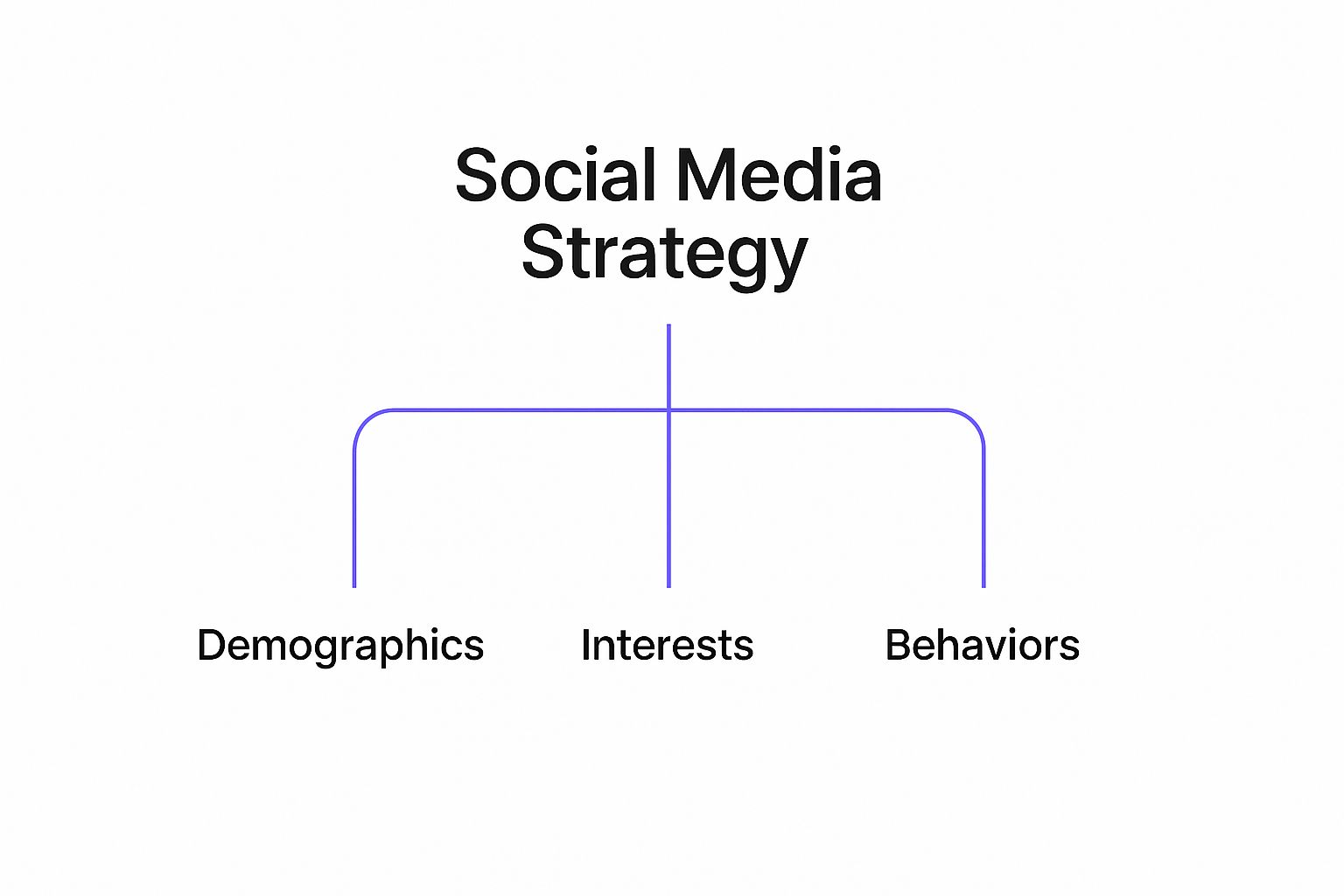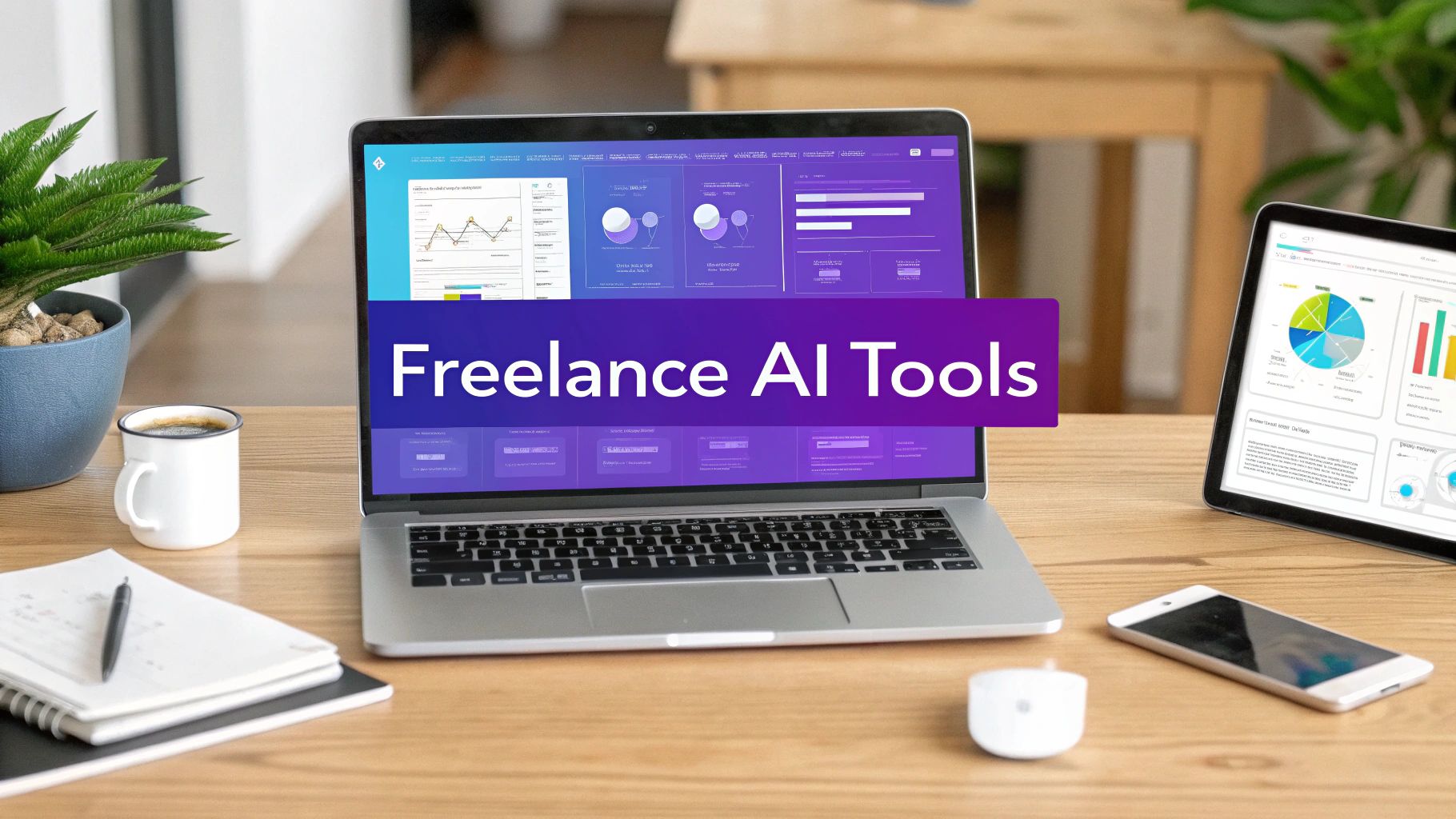What Is Social Media Strategy Your Ultimate Guide

So, what exactly is a social media strategy? Think of it as your master plan, the detailed blueprint for everything you do and hope to achieve on social media. It's the formal document that connects your daily social media activities back to your bigger business goals, making sure every single post and interaction has a clear purpose.
It's way more than just a content calendar—it's your entire game plan for winning online.
Your Blueprint for Digital Success

Ever tried building a house without a blueprint? You might end up with four walls and a roof, but the final product would be a chaotic, unstable, and inefficient mess. A social media strategy is that essential blueprint for your brand’s digital presence.
This plan lays out your specific goals, the tactics you'll use to hit them, and the metrics you'll track to know if you're succeeding. It’s what turns social media from a bunch of random activities into a focused, deliberate machine for connecting with your audience and driving real business results.
It’s like planning a cross-country road trip. Your strategy is the map that guides every turn. It ensures each post, campaign, and interaction brings you closer to your destination, keeping you from getting lost in the overwhelming noise of the digital world.
Why This Blueprint Matters
Without a clear plan, you're basically just shouting into the void and hoping someone hears you. A solid strategy, on the other hand, gives you direction and a reason for every move you make.
And with the sheer scale of social media today, this planning is non-negotiable. We're talking about 5.42 billion users worldwide—that's nearly two-thirds of the global population. The average person also juggles around 6.83 different social networks each month, making a smart, multi-platform approach essential.
A strong strategy helps you:
- Focus Your Efforts: Put your time and money where they’ll make the biggest splash.
- Stay Consistent: Make sure your brand’s voice, tone, and message are the same everywhere.
- Measure What Works: Track progress against clear goals to actually understand your return on investment.
A great social media strategy isn't about being on every platform. It's about being on the right platforms with a plan that genuinely connects with your audience.
It's easy to get strategy and management mixed up. One is about the "why" and "what," while the other is all about the "how."
Social Media Strategy vs Social Media Management
This table breaks down the difference between the high-level planning (strategy) and the day-to-day work (management).
| Aspect | Social Media Strategy (The Blueprint) | Social Media Management (The Execution) |
|---|---|---|
| Focus | Long-term goals, "why" & "what" | Daily tasks, "how" & "when" |
| Timeframe | Quarterly or yearly planning | Daily and weekly activities |
| Key Questions | Which platforms should we use? Who is our audience? What are our goals? | What should we post today? Who needs a reply? How did yesterday's post perform? |
| Activities | Setting goals, audience research, platform selection, budget allocation | Content creation, scheduling posts, community engagement, responding to DMs |
| Success Metrics | ROI, brand awareness growth, lead generation | Likes, comments, shares, follower growth, response time |
Seeing them side-by-side makes it clear: a strong strategy guides effective management. You can't have one without the other if you want to succeed.
Strategy vs Tactics
It’s also crucial to understand the difference between your strategy and your tactics. Think of it this way: strategy is the high-level plan, while tactics are the individual moves you make to execute it.
For instance, your strategy might be to increase brand awareness among young professionals. Your tactics to achieve that could be running targeted Instagram ad campaigns, collaborating with industry influencers, or creating short-form educational videos.
Building a detailed social media posting strategy playbook is a perfect example of a critical tactic within your broader blueprint. Likewise, knowing how to enhance your online presence is fundamental to making any plan a reality.
Why a Social Media Strategy Is Non-Negotiable
Trying to manage social media without a plan is like sailing a ship without a rudder. Sure, you’re moving, but you have no real control over your direction. You’ll probably end up drifting aimlessly—or worse, crashing into the rocks.
A formal strategy turns social media from a time-sucking chore into a powerful business asset. It’s the difference between just posting stuff and actually building something meaningful.
Turning Chaos Into Cohesion
A good plan ensures every single post has a purpose. It moves you from just broadcasting content to actually building connections, growing brand awareness, and hitting measurable goals. Without that strategy, your efforts are just a jumble of disconnected posts, making it impossible to know what’s working or why.
When you have a clear plan, you can finally align all your social activities with specific business objectives. This means every tweet, Reel, or story becomes a deliberate step toward a larger goal, whether that’s boosting sales, finding new leads, or making your current customers even more loyal. It gives your team direction and focus.
A social media strategy provides the consistency needed to form a brand identity that cuts through the noise and resonates with your target audience.
This consistency is absolutely critical for building trust. When your audience sees a coherent message and personality across platforms, they start to recognize and rely on your brand. The data backs this up: 78% of consumers say a brand’s social media presence impacts their trust, and that number jumps to a massive 88% for Gen Z.
From Time Sink to Revenue Driver
A strategic approach also turns your social media presence into a direct contributor to your bottom line. It gives you the framework you need to prove the return on investment (ROI) of your efforts, showing leadership exactly how social media is helping the business grow.
Ultimately, having a plan means you can:
- Boost Brand Awareness: A unified strategy makes your brand more memorable in a seriously crowded space.
- Enhance Audience Targeting: You can focus your resources on the platforms and content that truly connect with your ideal customers.
- Drive Website Traffic: Strategic content and clear calls-to-action guide followers from your social profiles right to your website.
- Generate Quality Leads: You can create specific campaigns designed to capture leads and guide them through your sales funnel.
Without a strategy, you’re just posting. With one, you’re building an engine for growth.
The Core Components of a Winning Strategy
A powerful social media strategy is built on several key pillars that work together, much like the essential ingredients in a complex recipe. Each component is critical, giving your plan the structure and direction it needs to succeed. Getting these elements right is what turns a simple document into an actionable framework for growth.
The whole process starts with a clear destination in mind. Without knowing what you want to achieve, your efforts will feel scattered and lack real impact. That’s why setting goals is the foundational first step.
Define Your Strategic Goals
Your goals are the "why" behind your entire strategy. They need to be specific, measurable, achievable, relevant, and time-bound (SMART). Vague objectives like "get more followers" just don't cut it. A much better SMART goal would be: "Increase our Instagram follower count by 15% among users aged 25-34 within the next quarter."
Setting clear, defined goals helps you:
- Justify Your Efforts: You can show stakeholders exactly what you’re aiming to accomplish and why it matters.
- Measure Success Accurately: It's easy to track progress when you have concrete numbers and timelines.
- Focus Your Content: Every post and campaign you create will directly support your objectives.
Once you know your destination, you need to understand who you're talking to. This means moving beyond basic demographics to build a deep, empathetic picture of your ideal customer.
Identify Your Ideal Audience
You can't connect with everyone, so the trick is to focus on connecting with the right people. This is where creating detailed buyer personas comes in—fictional representations of your ideal customers built from real data and solid market research. The process goes much deeper than just knowing someone's age and location.
The infographic below breaks down the key areas to explore when you're defining the audience for your social media strategy.

As you can see, a complete audience profile combines demographics with their deeper interests and online behaviors to create a full picture. When you understand what they care about and how they act online, you can craft a message that genuinely resonates. These insights form the core of any strong content marketing strategy guide, ensuring everything you create is relevant and valuable.
Conduct a Competitive Analysis
You’re not operating in a vacuum. Your competitors are out there fighting for your audience's attention, too. A competitive analysis is your chance to understand their strengths and weaknesses, allowing you to spot opportunities to stand out from the crowd.
Take a hard look at what your top three competitors are doing. Analyze their content, their engagement rates, their brand voice, and the platforms they prioritize. Are there gaps in their strategy you can fill? Maybe they’re ignoring a platform where your audience is active, or perhaps their content lacks a personal, human touch.
By studying the competition, you can learn from their successes and failures. This saves you time and resources while helping you carve out your own unique space in the market.
This research directly informs which platforms you should focus on and how you should communicate, leading you right into the next critical components: platform selection and brand voice. Choosing the right channels and establishing a consistent personality are what bring your strategic vision to life.
Building Your Content and Engagement Engine

If your strategy is the blueprint, then your content is the fuel and engagement is the engine that actually makes the car go. Without a steady supply of both, even the sharpest strategy is just a pretty document sitting on a shelf. The real goal here isn't just to broadcast your message; it's to build a lively community where people actually want to hang out and interact with your brand.
It all starts with defining your content pillars. Just think of these as the three to five core topics your brand will own. These pillars need to live at the sweet spot where your brand’s expertise meets your audience’s genuine interests. Get this right, and every single post will feel relevant and valuable.
A fitness apparel brand, for instance, might build its content around these pillars:
- Workout Tips: Actionable advice and exercise routines.
- Nutritional Guidance: Healthy recipes and simple meal prep ideas.
- Product Spotlights: Showing off new gear in real-world situations.
- Community Stories: Celebrating customer transformations and wins.
With clear pillars in place, you’ll never have that dreaded "what should we post today?" moment again. It keeps your content focused and tied directly to your bigger goals.
Creating Your Content Calendar
Once you know what you're going to talk about, the content calendar becomes your command center for when you'll talk about it. This is basically a schedule that maps out your posts in advance, making sure you show up consistently across all your channels. And consistency matters—a lot. In fact, 78% of consumers say a brand’s social media presence directly influences how much they trust them.
A solid calendar lets you plan content for weeks, or even months, ahead of time. It helps you balance your content pillars and schedule posts for when your audience is most active. To really get this process dialed in, it's worth learning about proven social media content planning strategies that can streamline your workflow and boost your impact.
A content calendar doesn't just organize your posts; it organizes your strategy. It turns your high-level goals into a day-to-day action plan that your entire team can follow.
This kind of organization creates a steady stream of quality content, which is the foundation you need to build a loyal community. With your content engine humming, you can shift your focus to sparking real conversations.
Fostering Meaningful Engagement
Engagement is so much more than likes and follows. It's about starting conversations and building actual relationships. This is the active, hands-on part of your strategy where you turn passive scrollers into passionate members of your community. It’s a two-way street, not a one-way broadcast.
The small things make a huge difference here. Respond to comments thoughtfully. Answer questions quickly. Give a shout-out to user-generated content. You can take it even further by creating interactive posts like polls, quizzes, or "ask me anything" sessions that practically beg your audience to jump in.
For a deeper dive, exploring specific social media engagement strategies can give you a ton of actionable ideas. Ultimately, your goal is to create a space where your followers feel seen, heard, and valued. That's how you turn them from followers into true brand advocates.
Measuring Your Strategy and Proving Its Value
A strategy is only as good as the results it brings in. If you're not measuring your performance, you're essentially flying blind, just hoping your efforts are hitting the mark. This is where tracking your performance becomes your secret weapon, allowing you to prove the value of your work and make smarter decisions down the road.
It all boils down to focusing on the right key performance indicators (KPIs). These are the hard numbers that tell you if you’re actually getting closer to your business goals. They help you cut through the noise of vanity metrics (like follower counts) and see what’s really working.
Identifying Your Core KPIs
While your specific KPIs will always tie back to your unique goals, a few metrics are universally important for understanding performance. Think of them as the vital signs for your social media health.
- Engagement Rate: This is the percentage of your audience that’s actually interacting with your content through likes, comments, and shares. A high engagement rate is a clear sign that your message is connecting.
- Click-Through Rate (CTR): This tells you how many people clicked a link in your post. CTR is a direct measure of how well your content inspires action, getting people to move from social media to your website or a landing page.
- Conversions: This is the big one. Conversions track how many people completed a specific action you wanted them to take—making a purchase, signing up for a newsletter, or downloading a guide.
Proving your strategy's worth isn't about showing how busy you are; it's about demonstrating how your social media activities directly contribute to business growth and revenue.
Making sense of these numbers means getting comfortable with your platform analytics. Every network, from Meta to X and LinkedIn, offers a treasure trove of data. The real skill is turning that raw data into insights you can actually use.
To really get the hang of it, check out our deep dive on what is social media analytics and learn how to turn those numbers into a compelling story.
To help you get started, here's a look at some of the most important metrics you should be tracking to gauge your strategy's effectiveness.
| Metric Category | Example KPI | What It Measures |
|---|---|---|
| Awareness | Reach & Impressions | The total number of unique users who saw your content and how many times it was seen. |
| Engagement | Likes, Comments, Shares | How your audience is interacting with your content, indicating resonance. |
| Traffic | Click-Through Rate (CTR) | The percentage of users who clicked a link in your post to visit your website. |
| Conversion | Conversion Rate | The percentage of users who completed a desired action (e.g., a sale or sign-up). |
| Audience | Follower Growth Rate | The speed at which your audience is growing, showing brand interest. |
| Customer Care | Response Rate & Time | How quickly and consistently you respond to audience messages and comments. |
| Table: Key Metrics to Track for Social Media Success |
By keeping a close eye on these KPIs, you can move beyond guesswork and start making data-backed decisions that drive real, measurable progress.
Proving Return on Investment
Showing the return on investment (ROI) is how you secure buy-in and justify your budget. This is especially true when you start putting money into paid advertising.
Social media ads are a massive part of any modern strategy, and for good reason. Global spending on social media advertising is projected to soar past $276 billion in 2025 and is expected to hit over $406 billion by 2029, according to data from inbeat.agency. That number alone shows just how vital this channel has become.
By tracking metrics like conversions and customer acquisition cost (CAC) from your social campaigns, you can draw a straight line between your ad spend and the revenue it generates. This continuous analysis allows you to tweak your approach, shift your budget to what’s performing best, and prove that your social media strategy is a powerful engine for growth.
Adapting Your Strategy with Modern Tools and Trends

A social media strategy is never a “set it and forget it” document. In fact, if you’re treating it that way, you’re already falling behind. The digital world simply moves too fast.
What worked six months ago might be totally obsolete today. Think about it—the explosion of short-form video, the rise of the creator economy, and the seamless integration of social commerce are all recent shifts. Ignoring them means letting your competitors eat your lunch.
To stay relevant, your plan needs to be a living, breathing blueprint. It has to adapt to new tools, evolving user habits, and whatever new trend is just around the corner. This means you have to be ready to pivot, constantly listen to your audience, and be willing to experiment.
The Rise of AI in Social Media Strategy
One of the biggest game-changers shaping modern strategy is artificial intelligence. AI isn’t some far-off concept anymore; it's a practical toolkit that can give you a serious edge. It’s fundamentally changing how brands plan and run their campaigns.
It's already happening at the highest levels. New survey data shows that over 75% of social media strategists, including C-level executives, are using AI to help with their work. This shows just how valuable it is for big-picture planning, not just day-to-day posts. You can dive into the full findings on how AI is shaping social media trends to see what’s coming next.
AI doesn't replace the strategist; it empowers them. It automates the tedious stuff, uncovers deep insights, and frees you up to focus on the creative and human elements that actually connect with people.
For example, AI-powered tools can sift through massive amounts of data to predict the next viral trend, figure out the absolute best time to post, or even help you draft content that speaks directly to a niche audience. This data-driven approach takes a lot of the guesswork out of the equation.
If you're ready to get started, it's worth exploring some of the best AI tools for social media that can streamline your workflow. By embracing these advancements, you can make sure your strategy isn’t just keeping up—it’s staying one step ahead.
Got Questions About Social Media Strategy?
Even the best-laid plans come with a few questions. It's totally normal. Let's tackle some of the most common ones that pop up when you're getting a social media strategy off the ground.
How Often Should I Update My Strategy?
Think of your social media strategy as a living, breathing thing—not something you carve into stone and forget about. A light review every quarter is a smart move. This is your chance to see how you're tracking against your goals and make small, informed tweaks based on what the data is telling you.
That said, you should plan for a major deep-dive at least once a year. You'll also want to revisit the whole thing any time your business goals take a sharp turn, you notice your audience is changing, or the social platforms themselves roll out a massive update.
Your social media strategy is a compass, not a rigid map. Regular checks ensure you're always heading in the right direction, even if the terrain changes.
Strategy Versus Campaign: What’s the Difference?
It’s easy to get these two mixed up, but telling them apart is key to really understanding what a social media strategy is all about.
Here's the breakdown:
- A strategy is your long-term blueprint. It's the big-picture vision for your entire social media presence, the North Star that guides every single thing you do.
- A campaign is a short-term, focused effort that lives inside that strategy. Think of it as a mini-mission with a specific, time-sensitive goal, like launching a new product or running a holiday sale.
Basically, campaigns have a clear start and end date. Your strategy is the always-on foundation that holds them all together.
Ready to build a powerful online presence that gets you noticed? MakerBox uses AI to create optimized bios, profile photos, and engaging content in seconds. Elevate your professional brand and start connecting with your ideal audience today.





